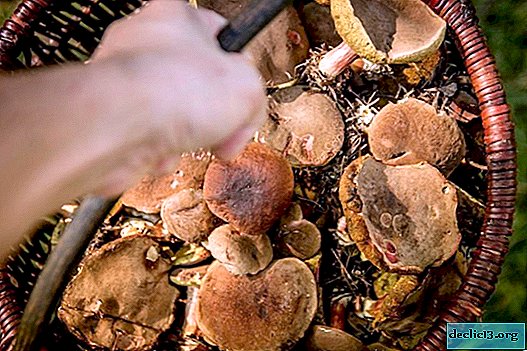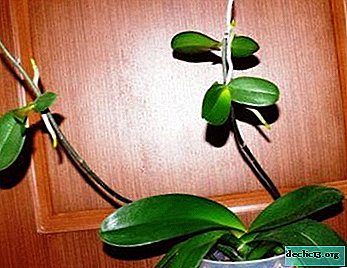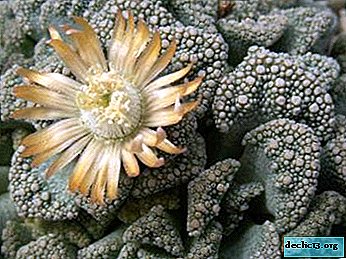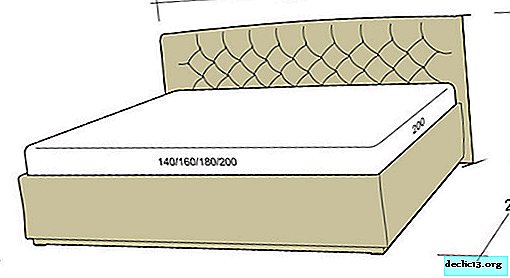Capricorn, jellyfish head, ornatum and other types of astrophytum. Cactus Star Care Rules
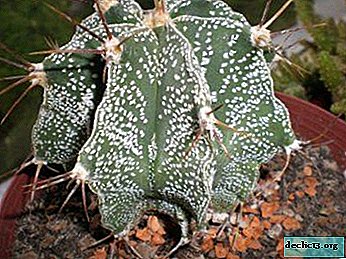
Astrophytum (Astrophytum) or a cactus star, came from a genus of spherical cacti of small size. Homeland - Mexico, southern US states.
Plants have the shape of a regular star, if you look at them from above, so the flower got that name. Astrophytums are characterized by felted light specks on the stem, which absorb moisture.
Some representatives have curved or slightly pronounced spines. The color of the stem is brown-green. Flowering occurs in the summer.
Description of plant species astrophytum and photos with them
Let us consider in more detail the types of succulent astrophytum. In the photo you can see how the varieties of the plant look.
Capricorn (capricorne, senile)
The astrophytum of Capricorn at the initial stage of development has a round, and after a cylindrical appearance. The trunk is dark green. There are curved long spines with light specks.
Features:
- Diameter up to 15 cm.
- Height is up to 25 cm.
- The color of the flowers is bright yellow, with a red circle in the center.
The plant is drought tolerant, does not require frequent fertilizer. The buds open in early summer or late autumn.

Coahuilense or Coahuilense
Astrophytum coahuilens has a gray-green stem color. At a young age, the trunk is spherical, acquires a columnar shape as it grows. Sharp ribs in the amount of 5 pieces. Lateral shoots do not develop. The flowers are large yellow with a pinkish or orange middle. Spines are absent.
Astrophytum coahuylene is resistant to low temperatures up to minus 4 degrees. Differs in slow growth. Demanding on intense sunlight.

Jellyfish head (caput medusae)
The jellyfish head astrophytum has a short cylindrical stalk with many bristles.
View Features:
- Width 2.2 mm.
- Height is up to 19 cm.
- Strong, curved thorns (length from 1 to 3 mm).
The flowers are bright yellow with a red middle.

Stellate (asterias)
Astrophytum stellate - slow-growing species, devoid of needles. The cactus reaches 15 cm, the color is gray-green. The number of ribs is 6-8 with areoles in the middle. The flowers are silky, yellow, 7 cm in diameter, 3 cm long. The middle has a reddish hue.
Star astrophytum in the spring is sensitive to direct sunlight. When switching to summer mode, the plant is shaded until it adapts to the sun.

Asterias Super Kabuto
Astrophytum Super Kabuto is a cultivar of Astrophytum stellate. This species was bred in Japan and does not occur in nature.
The cactus is notable for large open specks that are located over the entire surface.Distinctive features:
- Hard cover.
- Small stalk.
- The diameter of the mother plant is about 8 cm.
- Little halos.
- Snow-white specks.
Astrophytum asterias is very moody in his family. He painfully suffers when planting the deepening of the root neck.

Myriostigma (myriostigma)
Astrophytum myriostigmus (multifilament, thousand-speckled) is unpretentious. There are no needles, the trunk is dark green, covered with small gray-white specks.
Succulents of this genus are usually round and flattened. The number of edges is different (usually around 5). Flowers reach 6 m in diameter. The color is bright yellow, sometimes with an orange-red yawn.

Ornatum
Astrophytum ornatum (decorated) is in its way the highest. It extends up to 2 meters in height in the wild. Speckles are arranged in horizontal stripes. Stems at a young age are spherical in shape.
Key Features of Astrophytum ornatum:
- Dark green trunk with silver dots, divided into 6-8 ribs.
- Brown needles up to 4 cm long.
- The height in the room is 30-40 cm.
- Diameter 10-20 cm.
Day flowers, pale yellow. Succulents of this kind are unpretentious in care. Astrophytum ornatum (decorated) blooms when it is at least 25 years old. Young cacti of this species do not bloom.

Basic care rules
Astrophytums - photophilous succulents. They are best placed on southeast or south windows. Plants need year-round intense lighting. In extreme heat, position in the shade. In summer, the air temperature is maintained at about 20-25 degrees above zero.
For astrophytums, temperature differences are important day and night. In the summer, they must be carried overnight to a balcony or terrace. Cacti should be protected from precipitation. In autumn, the temperature is lowered to prepare for winter. No artificial lighting is required during this period.
Attention! In winter, the temperature regime for astrophytums should be in the range of + 10-12 degrees, otherwise flower buds will not form and the cacti will not bloom.They plant astrophytums in a special earthen mixture for succulents. It is better not to buy cheap substrates because of their poor quality. For planting, you can use the prepared soil by adding river sand. To prevent rot, add a little chopped charcoal.
Features of watering astrophytums:
- In the phase of intensive growth, the plant is watered regularly, but in moderation.
- Between waterings maintain intervals so that the earthen lump has dried out.
- In autumn, moisture is gradually reduced to a minimum; in winter, the soil is left dry.
- Astrophytums are watered with soft room water.
Moisture on the stem at the bottom is not permissible.
Transplant plants if necessary. Special fertilizers are applied once a month in the spring-summer period. For succulents, an influx of fresh air is important, so the room is often ventilated. Additional hydration is not necessary - natural moisture is enough.
Thus, astrophytums are a genus of spherical or cylindrical succulents from the cactus family. These plants are classified in different ways. Intraspecific varieties exist. Their taxonomists are combined into an independent group. Allocate 6 types of succulent astrophytum. Morphological types 5. Coahuilense and myriostigma are almost identical in appearance.
Useful video
We offer you to watch a video about the types of astrophytum and the rules for caring for it:


